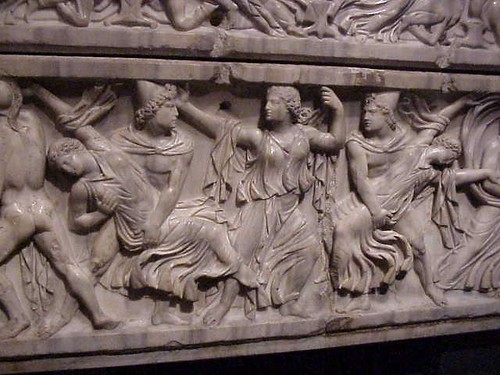
Aquincumi Museum: "At the beginning of urbanization, the architectural style of habitations used general Roman forms adopted to local conditions both in the Civil Town and in the area of the canabae. Mosaic floors made from tiny colored pieces of stone were among the most expensive luxury items. Only representative buildings financed from the state budget could muster such artistic features. Aquincum was the administrative center of Pannonia Inferior and the seat of the Legatus Augusti.
The Governor's Palace was built on todays Hajogyar Island. Its location in the northeastern corner of the canabae, across from the Barbaricum on the other site of the Danube, was supposed to demonstrate the monumentality and power of the Roman Empire. Public buildings of the governor's administration and the houses of high-ranking officials occupied the nothern zone of the canabae on the Obuda bank of the Danube branch separated by the island. Floors in the five large reception halls in the eastern, representative wing of the palace ere covered by mosaics as early as the beginning of the AD 2nd century. It is likely that mosaic artists trained in the Italian tradition were commissioned to make these floors characteized by bichromic, geometric patterns. The surface decorated by the contrasting effects of white limestone and black basalt, the rythmic elegance of simple geometric forms certainly showed the cultural superiority of Rome to visiting delegations from the Barbaricum. Meanwhile they were subtle enough not to distract the visitors' attention from the artistic wall-paintings and luxurious furniture. Thus, pompous receptions held in these halls had a full scale visual effect. Local mosaic artists in Aquincum are known only from the beginning of the AD 3rd century, that is the 'Golden Age of Severus'. Following the modification of the frontier by Caracalla in AD 214 the military power as well as political weight of Pannonia Inferior increased. Consesequently, the demand for representative mosaic work increased and such orders could provide a living for artists working in a local mosaic manufacturing workshop. In this new situation, it was again state and central funds that could be mobilized first. During the course of renovation and modernization in the northern bath wing new mosaic floors were laid as well. The central water drainage hole in the most impressive, octogonal exedra hall was surrounded by the figural pictures of a marine scene. In the surviving section of this mosaic picture a swordfish (Xiphias gladius) is chasing a carp-like creature (Cyprinidae) in the seacoast among the reeds. A mallard swims in the direction of a tree trunk covered with water plants such as bulrush, and a mussel is attached to a rock below. A huge dolphin plunges into the waves while a timid goldfish is escaping into the depths of the water. The aforementioned black and white tone dominates in the background of this mosaic that shows elements of incipient polychromism. Yellow highlights also appear in the band that frames the scene as well as in the dolphin's shiny body. The dolphin's eye and that of the goldfish are red. Both the style and execution of the black and white fish-scale patterns monotonously repeated in the frame motifs show harmonic similarity with AD 2nd century geometrical mosaics."

